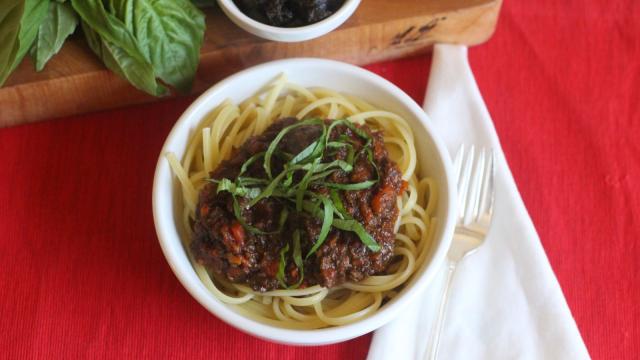My father is a pseudo-vegetarian, though he does eat the occasional bird or fish. He’s recently gotten into animal-free, meat-like products — the man loves an Impossible Burger! — and I’ve been making his favourite food (spaghetti) with either ground turkey or some sort of meatless crumble instead of beef or pork.
Impossible and Beyond “meats” and even crumbled tofu can get you close to the genuine article, texture-wise, but I often tweak and futz to make things taste a bit more meaty; meatiness is a specific kind of glutamate-heavy, umami-forward savoury flavour that you often miss when using a meatless meat. Using one (or more) of the following vegetarian- and vegan-friendly ingredients completes the flavour profile, resulting in a more satisfying meat-free eating experience.
Beef Stock
My stepmom has been using the Better Than Bouillon line of stock products for years, and she’ll often mix a little of this variety (sometimes in conjunction with browning sauce) into whatever vegetarian stew, stir fry or pasta dish she’s making to beef it up. It adds some of the nice, dark depth you get from roasted meat — kind of like a meatier-tasting soy sauce (if soy sauce was a paste). I like to add this stock towards the end of the cooking process, and to taste; and I rarely need more than a 1/2 teaspoon (1/4 is usually plenty).
MSG
Monosodium glutamate is the quickest way to get that pure hit of meaty savouriness. It doesn’t add much depth, so it’s especially useful in dishes where you’ve developed a ton of veggie-based flavour but are still missing that little meaty something. You just sprinkle it into or onto whatever fake meat product you happen to be using and cook as usual, or add it at the end to taste. Around 1/8th of a teaspoon per pound of protein is usually enough, though you can add as much as 1/4 of a teaspoon. (Any more than that and the MSG will dominate the dish in an unpleasant way.)
Chinese Olive Vegetable
This popular Chinese condiment is combination of immature Chinese white olives and mustard greens that has been cooked for a long time, creating a paste with a strong, savoury, complex flavour. It’s funkier and stickier than MSG (though some brands contain the glutamate salt), lending a quality kinda like aged beef. I like to mix it with a bunch of crispy minced mushroom bits to make a vegan bolognese, but you can use it just like the no-beef BTB and mix it in to taste. (Just look out for olive pits.)
Burnt Onions
A burnt onion doesn’t add quite the same pure, meaty flavour as the above three, but it does bring a savoury darkness, and sometimes that is enough. The charred allium adds a roasted quality and a bit of bitterness — two things one often associates with meaty stews and braises. (Just as liquid smoke can make remind one of a grilled burger while not actually tasting meaty, burnt onions can remind one of a roast.) Burnt onions work best when pureed into something, particularly sauces and stews. (Just cook a whole onion until it’s way past caramelised, then blend it in with an immersion blender.)

Leave a Reply
You must be logged in to post a comment.